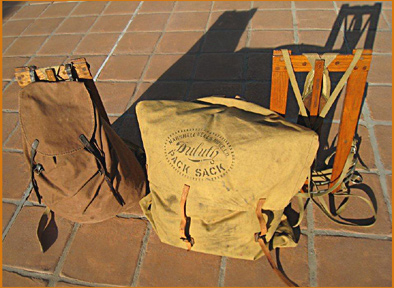
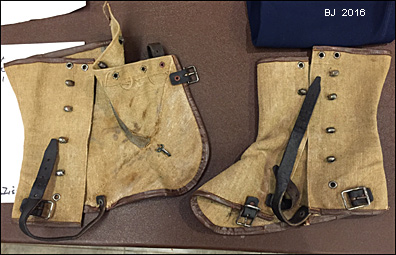


(images above): three 1920-era packs, all made or sold in Portland, Oregon--- a "Duluth" pack sold at famous Portland hardware store Marshall-Wells Hardware Co.; and two "Wy'Easter" brand packs, made in Portland (Wy'Easter also made ice axes). Image credit: Peter Ireland... Image on right: a pair of gaitors from the early 1930s, which was before the invention of nylon. This was also a time in the history of gear before velcro, and a time when the only zippers available were made of metal.
Images below are from the 1960 EUREKA TENT catalog, commemorating their being in business since 1895 and celebrating what was the company's best expeditionary tent design.... The ad copy states that this Blanchard Draw-Tite "Alpine" tent uses "Mountain Cloth" for its canopy. Unfortunately Eureka's vaunted "Mountain Cloth" was NOT some version of the same nylon fabrics then in use by the likes of Alice Holubar and Gerry Cunningham in their cutting-edge clothing designs of the 1950s. Nevertheless, Eureka is proud of this tent, saying "It is the approved polar tent for arctic exploration." These were fairly heavy tents due to the combination of "chrome aluminum" poles, and the 6.6oz. poplin (aka Mountain Cloth) canopies, and the vinyl-coated nylon floors. Even the one-man size of the Alpine weighed 8 pounds, while the two-man size weighed 12 1/2 pounds! Note: the Mountain Cloth was fairly waterproof by itself, and so no rainfly was supplied.
In terms of
History of Gear innovation, the Blanchard Draw-Tite tents were among the first
to use a fully-external frame, which allowed the user to
erect these tents without ever needing to get inside them; this
frame also made the tent an early forerunner of the true self-supporting
dome designs that were going to come along in the mid-1970s from
The North Face and Snowlion......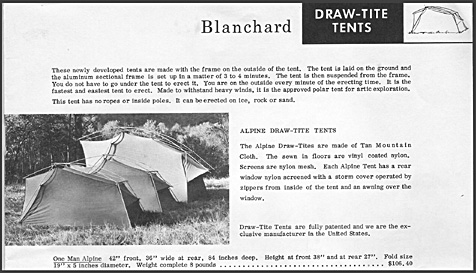 Eureka's other innovative
product in 1960 was NOT the Mountain Cloth that it bragged about
in the tent ad copy--- it was a new fabric it had been working
on for 18 months with DuPont. They named it "Polaris Cloth"
(see second image below). Polaris Cloth, a 100% nylon fabric
(weight per yard not listed),
Eureka's other innovative
product in 1960 was NOT the Mountain Cloth that it bragged about
in the tent ad copy--- it was a new fabric it had been working
on for 18 months with DuPont. They named it "Polaris Cloth"
(see second image below). Polaris Cloth, a 100% nylon fabric
(weight per yard not listed),  was
only being introduced by Eureka in 1960, and was available only
as a custom-order fabric. This was huge for such a big traditional
tent company to step forward and transition itself into modern
nylon fabrics. Hurrah for Eureka as a major outdoor supplier to
lead the way so publicly.
was
only being introduced by Eureka in 1960, and was available only
as a custom-order fabric. This was huge for such a big traditional
tent company to step forward and transition itself into modern
nylon fabrics. Hurrah for Eureka as a major outdoor supplier to
lead the way so publicly.
Segen Packs, Eugene,
very early 1970s ("Segen
Pax," Elegant laminated hardwood frames, a combination of
the best modern materials with the best of "organic"
old tech materials like cotton duck. 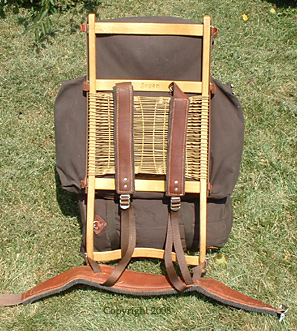 The
comany's tagline was "Advanced Simplicity" and the pack
was touted as a "Natural Pack." Note: the Segen section
is under development, but here is one picture, from contributor
Terry, and below is from contributor Peter I., who lives in Southern
California. ..he's a person who actually owns and uses the Segen
packs that he's acquired (yes, he owns more than one!):
The
comany's tagline was "Advanced Simplicity" and the pack
was touted as a "Natural Pack." Note: the Segen section
is under development, but here is one picture, from contributor
Terry, and below is from contributor Peter I., who lives in Southern
California. ..he's a person who actually owns and uses the Segen
packs that he's acquired (yes, he owns more than one!):
"It is very hard to get any info on that company...and I have tried. I even had someone drive by the old address in Eugene [190 River Loop One, zip 97404], contact the Mazamas, the local Sierra Club chapter, called local gear suppliers in Oregon, etc. No one knew anything. I do remember seeing a color magazine ad on the internet. That gave some information. Glad you have included them in your research! Segen deserves special mention because they combined the vintage tradition of wood external frame & canvas rucksack with a modern hip belt suspension while staying true to the use of classic natural materials of wood, canvas, leather and wool felt. A very noble effort with true old school craftsmanship. Everyone who has seen one...their mouth drops open and they just say 'Wow!' 'What is that"? 'That is beautiful'... " Peter goes on to summarize:
"Segen almost seems to be a reaction to the modern era of synthetics, plastics, alloys and composites. A desire to put 'Mother Earth' back into the age-old recreational activity of backpacking. They did a fantastic job of establishing the 'Earth' connection in their product. I know they were not in the realm of modern technical mountaineering gear but what they produced, I feel, may be described as the most 'beautiful hand-made backpack ever'. The fact that they were native to Oregon should make every Oregonian proud. Their products are in the category of 'folk art' and exhibit the highest level of hand made craftsmanship."
The Candle
Lantern that many of us older backpackers loved in the 1970 and
80s actually dates far back into antiquity. But here in America
the modern candle lantern got its start in the early 1980s, displacing
lesser models from France and Japan. 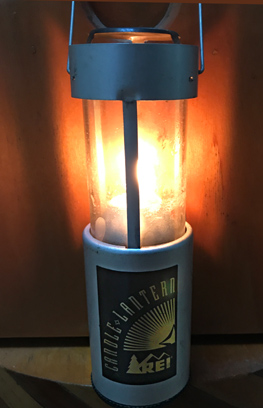 At
that time, Early Winters of Seattle approached a small Seattle-area
manufacturing company named UCO with design ideas for a modernized
candle lantern. It sold well at Early Winters, and by 1984 UCO
had redesigned the EW model and began selling it widely to most
of the prominent companies of the time: LL Bean, EMS, Cabelas,
REI and many others. The lantern by UCO became a wild success
and is still made by UCO. Pictured is one made for REI in the
later 80s. Turn it upside down and on the plastic base you'll
see inscribed "UCO, Redmond, Washington." Greg Draper, Bill Edwards, Keith
Jackson
At
that time, Early Winters of Seattle approached a small Seattle-area
manufacturing company named UCO with design ideas for a modernized
candle lantern. It sold well at Early Winters, and by 1984 UCO
had redesigned the EW model and began selling it widely to most
of the prominent companies of the time: LL Bean, EMS, Cabelas,
REI and many others. The lantern by UCO became a wild success
and is still made by UCO. Pictured is one made for REI in the
later 80s. Turn it upside down and on the plastic base you'll
see inscribed "UCO, Redmond, Washington." Greg Draper, Bill Edwards, Keith
Jackson